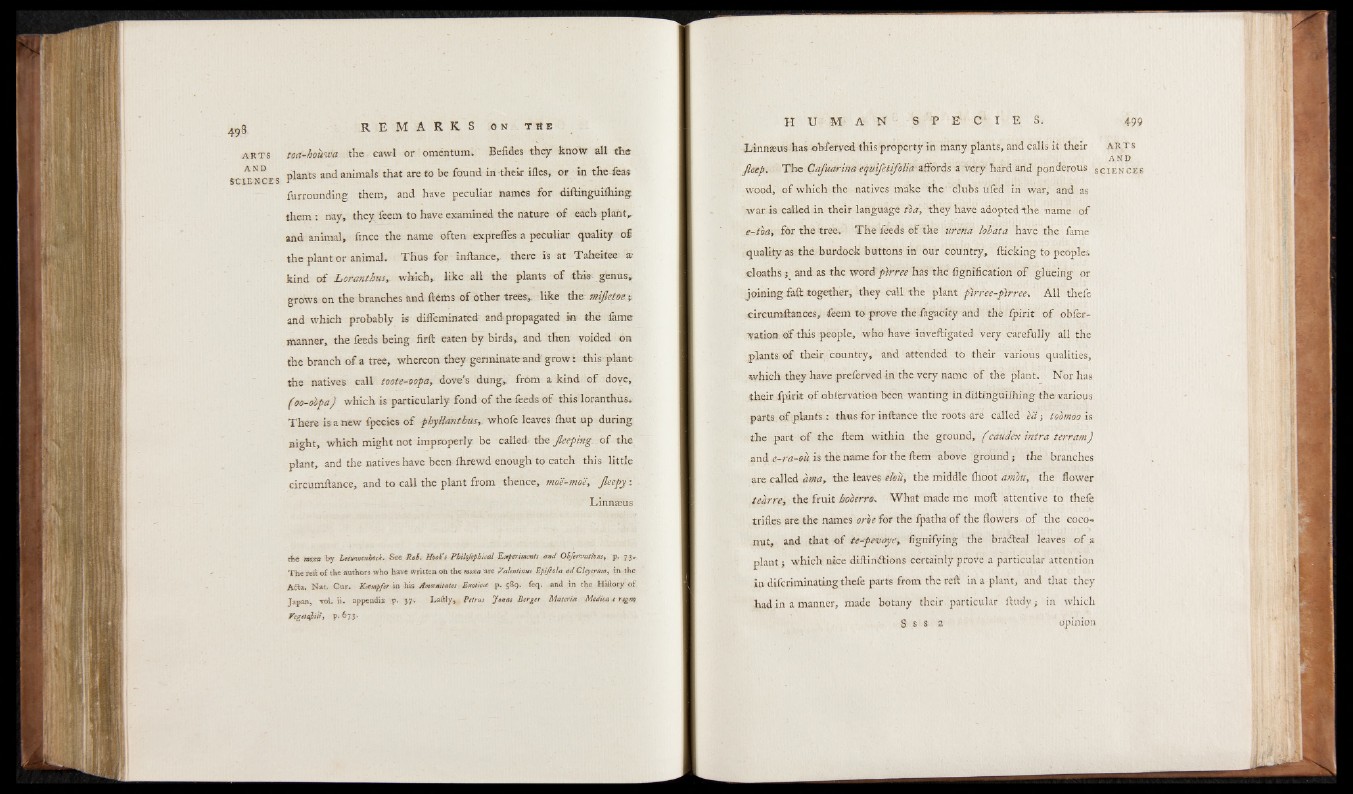
a r t s toa-howwa the cawl or omentum* Befides they know all the
AND Diants and animals that are to be found in their ifles, or in the Teas SCIENCES r*
furrounding them, and have peculiar names for diftinguifhing
tliem : nay, they feem to have examined the nature o f each plants
and animal, fmee the name often exprefles a peculiar quality o f
the plant or animal. Thus for mftance, there is at Taheitee at
kind o f LorantJms,. which, like all the plants o f this genus,
grows on the branches and items o f other trees,, like the mijlstor p
and which probably is difleminated and.propagated in the lame
manner, the feeds being firft eaten by birds, and then voided on
the branch o f a tree, whereon they germinate and grow: this plant
the natives call toote-oopa, dove's dung, from a kind o f dove,
(oo-oopa) which is particularly fond o f the feeds o f this loranthus.
There is a new fpecks o f fbyUanthus, whofe leaves ihut up during
night, which might not improperly be called the fleepirtg o f the
plant, and the natives have been ihrewd enough to catch this little
circumftance, and to call the plant from thence, mae-moe, Jleepy:
Linnaeus
rfrt m o xn by L e euw en h o e k . See R e f . Hook’s Fhihfophieal E x p e r im e n t s a n d O h fe rnm th n s t p. 73-
The reft of the authors who have written oft the m o xa are Valentinus E p if io la a d C ley eram , in the
Acta. Nat. Cur. K am p fe r in his Amceriitates E x o t i c a p. 589. feq. and in the Hiftory o f
Japan, voL ii. appendix p. 37. Laftly* P e tr u s J o n a s B e r g e r M a t e r ia M e d iea e regno
V eg e ta fc ili, p- 67.3,
Linnaeus h a s obferved this property in many plants, and calls it their a r t s
AND
Jlaep. Th e Cafuarim equifetifilia affords a very hard and ponderous s c ien c e s
wood, o f which the natives make the' clubs ufed in war, and as
war, is called in their language tea, they have adopted -the name o f
e-toa, for the tree. T h e feeds of the arena lobata have the fame
quality as the burdock buttons in our country, flicking to peoples
cloaths; and as the word pirree has the fignification o f glueing or
joining fail together, they call the plant pirree-pirree. A l l thefe
circumftanccs, feem to prove the.fagacity and the fpirit o f obfer-
vatioa e f this people, who have inveftigated very carefully all the
plants o f their country, and attended to their various qualities,
which they have preferved in the very name o f the plant. Nor has
their fpirit o f obfervation been wanting in diftinguifhing the various
parts o f plants : thus for inftance the roots are called eii; toomoo is
the part o f the flem within the ground, ( caudex intra terram)
and e-ra-eu is the name for the flem above ground; the branches
are called attta, the leaves eh'u, the middle fhoot ambu, the flower
tearre, the fruit bo'oerra. What made me moil attentive to thefe
trifles are the names orse for the fpatha of the flowers o f the coconut,
and that o f te^penayi\ figmfying the bradteal leaves o f a
plant; which nice diftinftions certainly prove a particular attention
in diferiminating thefe parts from the reft in a plant, and that they
had in a manner, made botany their particular ftudy; in which
S s s 2 o p in i o n